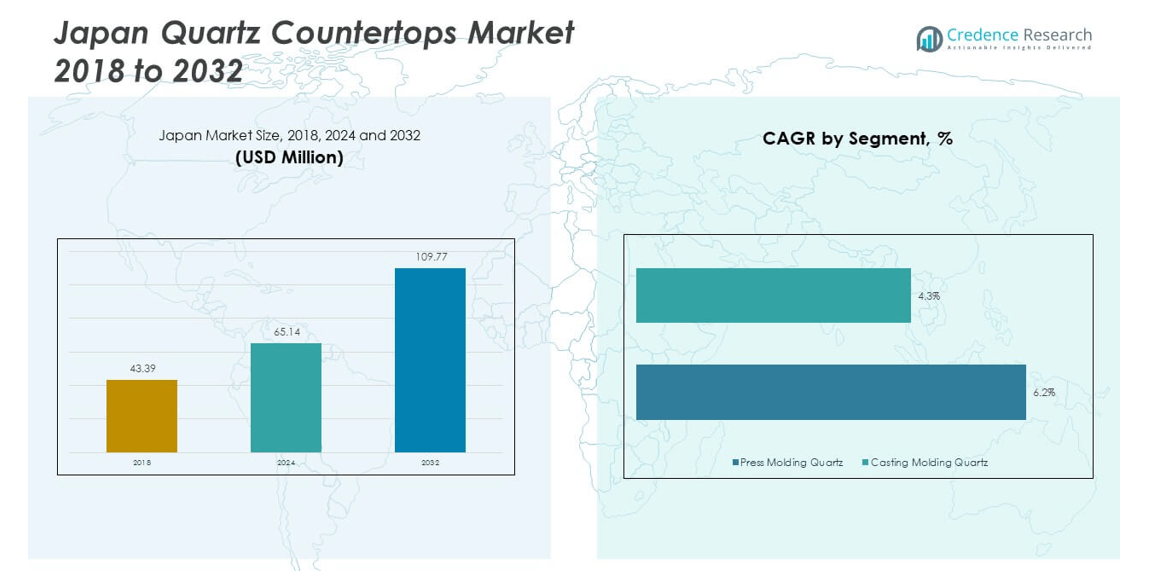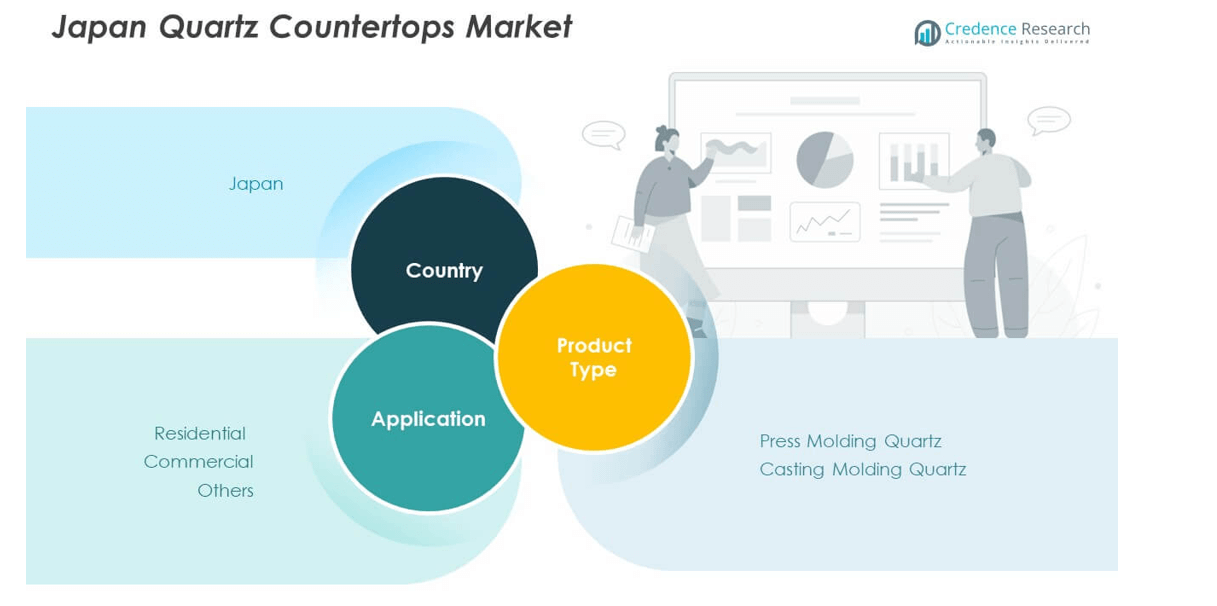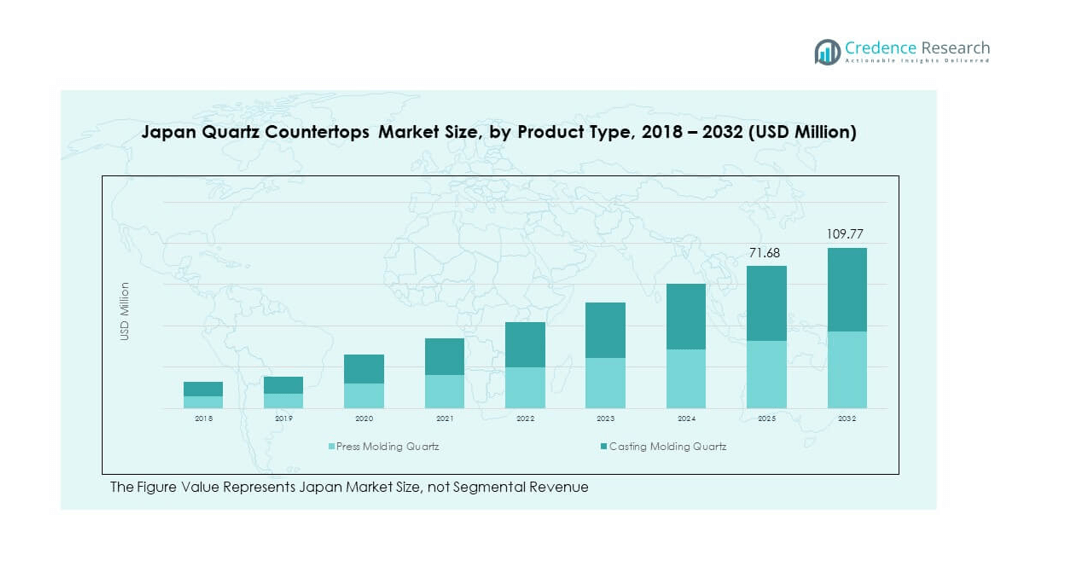Market Overview:
The Japan Quartz Countertops Market size was valued at USD 43.39 million in 2018 to USD 65.14 million in 2024 and is anticipated to reach USD 109.77 million by 2032, at a CAGR of 6.28% during the forecast period.
| REPORT ATTRIBUTE |
DETAILS |
| Historical Period |
2020-2023 |
| Base Year |
2024 |
| Forecast Period |
2025-2032 |
| Japan Quartz Countertops Market Size 2024 |
USD 65.14 million |
| Japan Quartz Countertops Market, CAGR |
6.28% |
| Japan Quartz Countertops Market Size 2032 |
USD 109.77 million |
Strong demand for durable, low-maintenance, and aesthetically appealing surfaces continues to drive this market in Japan. Growth in urban housing, rising renovation activities, and increasing preference for modern kitchen and bathroom interiors are pushing adoption. Consumers are showing greater awareness of non-porous, hygienic materials, while the hospitality and commercial sectors increasingly integrate quartz surfaces for premium designs. Expansion in construction activities, combined with a rising middle-class population and higher disposable incomes, further strengthens market development. Innovation in designs and finishes, offering both functional and decorative appeal, adds momentum to market expansion.
Regionally, the Japan Quartz Countertops Market benefits from its robust construction sector and design-conscious consumer base. The urban centers of Tokyo, Osaka, and Yokohama lead demand due to concentrated real estate projects and rising consumer spending on premium home interiors. Emerging regions are beginning to adopt quartz countertops, influenced by growing modernization, retail expansion, and the rising influence of Western-style kitchens. With ongoing infrastructure projects and high adoption of imported materials, Japan remains a key player in the broader Asia-Pacific quartz countertop landscape.

Market Insights:
- The Japan Quartz Countertops Market was valued at USD 43.39 million in 2018, reached USD 65.14 million in 2024, and is projected at USD 109.77 million by 2032, growing at a CAGR of 6.28%.
- Tokyo, Osaka, and Yokohama together command over 55% share, driven by dense urban housing and high commercial construction.
- Nagoya, Fukuoka, and Sapporo contribute nearly 30% share, supported by modernization projects and rising middle-class demand.
- Smaller cities and rural areas hold 15% share, representing gradual adoption supported by retail expansion and affordability improvements.
- Press molding quartz leads with around 70% share due to strength and consistency, while casting molding quartz holds nearly 30% share, favored for design flexibility and customization.
Access crucial information at unmatched prices!
Request your sample report today & start making informed decisions powered by Credence Research Inc.!
Download Sample
Market Drivers:
Growing Preference For Durable And Low-Maintenance Surfaces
The Japan Quartz Countertops Market benefits from a steady shift toward surfaces that combine durability and low maintenance. Homeowners and commercial buyers increasingly demand non-porous, scratch-resistant, and stain-resistant materials that ensure long-term use. The market growth aligns with rising awareness of hygiene and easy cleaning features. Japan’s consumers value efficiency and design, making quartz countertops a favored choice over natural stones like granite or marble. Continuous adoption in modern apartments and offices highlights this preference. Renovation and remodeling activities strengthen this trend, supported by growing disposable incomes. Manufacturers are introducing new shades and finishes to meet evolving consumer needs.
- For instance, Caesarstone’s quartz countertops launched in Japan as part of the 2025 ICON™ collection are certified to achieve a Mohs hardness of 7 and feature over 95% non-porous surfaces, attributes confirmed through independent laboratory testing and official company disclosures.
Impact Of Urbanization And Rising Real Estate Development
Rapid urbanization and real estate development are fueling the demand for premium interior materials across Japan. The quartz countertop industry finds a strong market in cities like Tokyo, Osaka, and Yokohama where high-rise apartments and modern kitchens dominate. It benefits from ongoing residential and commercial construction projects focused on aesthetics and functionality. Real estate developers and contractors prefer quartz due to its consistent quality and availability. Increasing investment in housing and office renovation also expands adoption. Rising household incomes and consumer focus on stylish interiors drive further growth. The appeal of quartz countertops as a modern lifestyle element enhances this demand. The Japan Quartz Countertops Market continues to build momentum from these developments.
Rising Influence Of Hospitality And Retail Sectors On Countertop Demand
The hospitality and retail industries play a vital role in shaping demand for premium countertops in Japan. Hotels, restaurants, and shopping complexes prioritize design elements that create lasting impressions. Quartz countertops provide the combination of elegance and resilience that these spaces require. The growing food service and hospitality sector contributes to expanding installations across dining and reception areas. Commercial establishments also value the hygienic benefits that quartz surfaces provide. The industry’s emphasis on customer experience drives investment in modern interiors. Growing retail expansion further accelerates adoption, as quartz aligns with functional yet decorative design standards. It gains traction as a versatile solution supporting multiple sectors.
Innovation In Designs, Colors, And Finishes Boosting Market Adoption
The Japan Quartz Countertops Market experiences strong momentum from product innovation. Manufacturers continuously develop new patterns, colors, and finishes that mimic natural stones while offering greater durability. It allows consumers to access a broad design range suitable for traditional and modern interiors. Japanese buyers show high responsiveness to unique and aesthetically appealing surfaces. Innovation also helps manufacturers compete with natural alternatives by providing distinctive value propositions. Improved production technologies enhance quality and performance consistency. Brands that highlight customization and eco-friendly processes gain stronger acceptance. This trend reflects growing consumer willingness to invest in premium surfaces with advanced features.
Market Trends:
Sustainability And Eco-Friendly Countertop Manufacturing Processes
The Japan Quartz Countertops Market is witnessing growing attention to sustainability in product manufacturing. Companies increasingly adopt eco-friendly processes that minimize carbon emissions and use recycled raw materials. It aligns with Japan’s strong regulatory framework on environmental responsibility. Consumers are more aware of sustainable living and prefer products that meet these values. Manufacturers highlight green certifications to enhance credibility in the market. Quartz countertops positioned as eco-conscious choices gain wider acceptance. This shift promotes innovation in material sourcing and production techniques. The emphasis on environmental sustainability creates a distinct competitive edge for leading brands.
- For instance, Caesarstone’s ICON™ series, launched in July 2025, is made with approximately 80% recycled materials and is Greenguard Gold certified for low VOC emissions, aligning with Japan’s environmental standards as reported in official company publications and third-party certification listings.
Customization And Personalization In Residential And Commercial Spaces
An important trend shaping the Japan Quartz Countertops Market is the rise of customization. Homeowners and businesses want personalized designs that reflect individual styles and functional requirements. It encourages manufacturers to offer tailor-made surfaces in varied sizes, colors, and textures. The trend is prominent in premium residential projects and luxury commercial spaces. Japanese consumers appreciate attention to detail, making customization a valuable selling point. Retailers are expanding portfolios to showcase unique and modern design concepts. The shift supports differentiation among competitors and strengthens brand loyalty. Growing interest in bespoke solutions is expected to remain a major driver of future adoption.
- For instance, Hyundai L&C, the owner of the HanStone Quartz brand, introduced its 2025 surface collection featuring a variety of colors, building on its history of providing engineered stone for custom installations in residential and commercial projects globally.
Integration Of Quartz Countertops In Smart And Modern Kitchens
Smart kitchens are emerging as a key trend in Japanese households, boosting quartz countertop demand. Consumers prioritize seamless integration of technology with interior design. Quartz provides the ideal platform for modern kitchens by offering durability and sleek aesthetics. It complements energy-efficient appliances and modular kitchen designs. The adoption of quartz countertops aligns with growing interest in intelligent and space-saving interiors. Developers in urban housing projects focus on modern amenities where quartz plays a central role. Demand rises as consumers view quartz as both a practical and aspirational choice. This trend highlights quartz as a core element in smart home design evolution.
Rising Popularity Of Imported Quartz Designs And Global Influences
Global influences are shaping design preferences in Japan, leading to rising popularity of imported quartz designs. Consumers show interest in styles inspired by European and American markets. The Japan Quartz Countertops Market adapts to these shifts by importing premium varieties and finishes. It creates a diverse range of offerings that appeal to design-conscious buyers. International brands find opportunities to strengthen their presence in Japan. Japanese firms also collaborate with global players to expand product lines. The infusion of international design elements raises competition and innovation. The trend highlights Japan’s integration into global interior design movements.

Market Challenges Analysis:
High Competition From Natural Stones And Alternative Materials
The Japan Quartz Countertops Market faces intense competition from natural stones such as granite and marble. Many consumers still view natural stone as a premium and prestigious option for interiors. It creates a challenge for quartz manufacturers to position their products effectively. Competing alternatives like ceramic and solid surface countertops also reduce market share. High consumer loyalty toward traditional materials limits rapid adoption in some regions. Price sensitivity in specific customer segments adds to competitive barriers. Marketing efforts must emphasize quartz’s durability, hygiene, and design flexibility. Overcoming this challenge requires targeted awareness campaigns and stronger differentiation strategies.
Supply Chain Constraints And Rising Cost Of Raw Materials
The market also struggles with supply chain challenges and rising raw material costs. Dependence on imported quartz, pigments, and resins impacts overall pricing structures. It creates volatility for manufacturers trying to maintain competitive prices. Transportation disruptions and global trade fluctuations further complicate availability. Smaller manufacturers face difficulty in securing stable supply contracts. Rising production costs are often passed on to consumers, affecting affordability. These pressures restrain market expansion and create barriers for new entrants. The Japan Quartz Countertops Market must balance cost efficiency with product innovation. Strategic partnerships and localized sourcing could help mitigate these risks.
Market Opportunities:
Expansion In Renovation And Remodeling Activities Across Japan
The Japan Quartz Countertops Market presents strong opportunities in the renovation and remodeling segment. Growing demand for home improvement projects supports rising installations in kitchens and bathrooms. It benefits from consumer preference for stylish, hygienic, and long-lasting surfaces. The trend is reinforced by increasing disposable incomes and lifestyle upgrades. Quartz countertops offer a balance of functionality and aesthetics, making them suitable for both residential and commercial upgrades. It positions manufacturers to target urban homeowners seeking modernized interiors. The surge in renovation creates consistent demand for new designs and premium finishes.
Emergence Of Smart Housing Projects And Modern Interiors
Smart housing developments and modern interior concepts create significant growth avenues for quartz countertops in Japan. Builders incorporate quartz into high-end residential projects due to its versatility and visual appeal. It fits well with the evolving demand for modular and technologically integrated spaces. Urban housing projects that emphasize contemporary design rely on quartz for premium finishes. International design trends influence Japanese consumer preferences, creating new opportunities for product innovation. The Japan Quartz Countertops Market is well positioned to capture this growth with evolving product lines. Strategic alliances and promotional campaigns could further unlock its potential.
Market Segmentation Analysis:
By Product Type
Press molding quartz holds a significant share in the Japan Quartz Countertops Market due to its strength, uniformity, and wide use in modern interiors. It is favored for both residential and commercial projects where durability and consistent appearance are priorities. Casting molding quartz, while smaller in share, is gaining traction for its flexibility in producing customized designs and patterns. This segment appeals to design-conscious consumers who seek unique finishes. Both segments benefit from advancements in processing technologies that improve quality and expand design choices.
- For instance, Technistone quartz surfaces distributed in Japan and produced under the Wilsonart group have achieved compressive strength over 80 MPa in tests, according to the company’s official documentation which specifies a guaranteed strength of 40–90 MPa.
By Application
The residential segment dominates demand, driven by home renovation projects and rising adoption of stylish kitchen and bathroom countertops. Japanese homeowners prioritize durability, hygiene, and aesthetic appeal, making quartz a preferred option over natural stone alternatives. The commercial segment follows, with strong demand from hospitality, retail, and office spaces that require functional yet elegant surfaces. Quartz countertops provide the necessary durability for high-traffic environments while enhancing design value. The others segment, including institutional and specialty applications, reflects growing experimentation with quartz in diverse interior projects.
- For instance, Cosentino opened a new “Cosentino City” showroom in Tokyo during 2022 to strengthen its presence in the Asia-Pacific market for materials like Silestone and Dekton.

Segmentation:
By Product Type
- Press Molding Quartz
- Casting Molding Quartz
By Application
- Residential
- Commercial
- Others
By Country (within scope of analysis)
- Country-wise Revenue Share
- Product Type Revenue by Country
- Application Revenue by Country
Regional Analysis:
Dominance of Urban Hubs
The Japan Quartz Countertops Market is highly concentrated in major metropolitan areas such as Tokyo, Osaka, and Yokohama, which collectively account for more than 55% of the national share. These cities represent strong demand from both residential and commercial construction sectors, where premium interiors are in high demand. Urban consumers prioritize modern designs, hygienic features, and durable surfaces, making quartz countertops an attractive choice. Real estate development projects, especially high-rise apartments and luxury housing, reinforce the preference for quartz surfaces. Hospitality and retail projects in these regions also expand adoption, with quartz becoming a standard for premium design elements. The clustering of construction activity in urban hubs keeps this share dominant.
Growth In Emerging Regional Markets
Regional markets beyond the major cities, including areas such as Nagoya, Fukuoka, and Sapporo, hold close to 30% of the market share. These regions show rising adoption supported by expanding urbanization and lifestyle upgrades among middle-income groups. Government-driven housing initiatives and infrastructure modernization projects support growth in countertop demand. Homeowners in these markets increasingly adopt quartz due to its low-maintenance nature and long-term value. Developers also incorporate quartz surfaces to align with modern housing preferences. The growing penetration of international design trends helps spread awareness of quartz advantages in these regions. It strengthens the overall growth trajectory of the market.
Niche Growth In Smaller Cities And Rural Regions
Smaller cities and rural areas together contribute nearly 15% of the Japan Quartz Countertops Market. Their growth pace is slower compared to urban hubs, but rising awareness of premium interior materials is fostering gradual adoption. Affordability challenges limit penetration, yet manufacturers are introducing cost-effective product lines to target these segments. Local distributors and retail expansion play a key role in creating accessibility for quartz countertops in smaller markets. Renovation and remodeling activities in rural housing projects provide limited yet steady demand. It offers opportunities for brands to widen their presence and educate consumers on the benefits of quartz. The gradual rise in disposable incomes and improved distribution channels supports future potential.
Shape Your Report to Specific Countries or Regions & Enjoy 30% Off!
Key Player Analysis:
- Camrola Quartz
- Caesarstone
- INAX (LIXIL Group)
- Tostem Corporation (LIXIL)
- Toto Ltd.
- HanStone Quartz Japan
- Vicostone
- Technistone
- Quarella
- Cosentino
Competitive Analysis:
The Japan Quartz Countertops Market is moderately fragmented, with both domestic and international players competing for share. Leading companies such as INAX (LIXIL Group), Toto Ltd., HanStone Quartz Japan, and Caesarstone focus on product innovation, design variety, and brand positioning to strengthen their presence. Global players like Cosentino and Vicostone continue to expand distribution networks, targeting urban centers with rising demand. It benefits from increasing consumer preference for stylish and durable interiors, which raises competition among brands. Differentiation relies on technological advances, eco-friendly processes, and customization capabilities. The market also reflects strong collaboration between real estate developers and manufacturers, driving competitive dynamics.
Recent Developments:
- In August 2025, Toto Ltd. announced the upcoming launch of a smart home-use toilet that measures stool analysis parameters, including amount and hardness, demonstrating ongoing innovation in bathroom technology and individualized wellness at home. The release is scheduled for August 2025, targeting the Japanese market.
- In July 2025, Caesarstone launched the Caesarstone ICON™ collection in the Japanese quartz countertops market, introducing advanced fusion surfaces that are crystalline silica-free and made with approximately 80% recycled materials. The launch addresses industry needs for sustainable and safer surfacing products, with unique depth and dimension in their design offerings.
Report Coverage:
The research report offers an in-depth analysis based on product type and application segments. It details leading market players, providing an overview of their business, product offerings, investments, revenue streams, and key applications. Additionally, the report includes insights into the competitive environment, SWOT analysis, current market trends, as well as the primary drivers and constraints. Furthermore, it discusses various factors that have driven market expansion in recent years. The report also explores market dynamics, regulatory scenarios, and technological advancements that are shaping the industry. It assesses the impact of external factors and global economic changes on market growth. Lastly, it provides strategic recommendations for new entrants and established companies to navigate the complexities of the market.
Future Outlook:
- Rising demand for durable and hygienic surfaces will drive steady growth.
- Product innovation with unique colors and textures will enhance consumer appeal.
- Sustainability will remain central, with increased adoption of eco-friendly quartz production.
- Residential renovations will dominate demand across urban regions.
- Commercial expansion in hospitality and retail will create consistent opportunities.
- Global design trends will continue to influence Japanese consumer preferences.
- Partnerships with developers and distributors will strengthen market penetration.
- Smart housing and modular kitchens will integrate quartz surfaces more widely.
- Regional adoption will expand in emerging cities as incomes rise.
- Growing competition will push companies toward differentiation through technology and branding.










